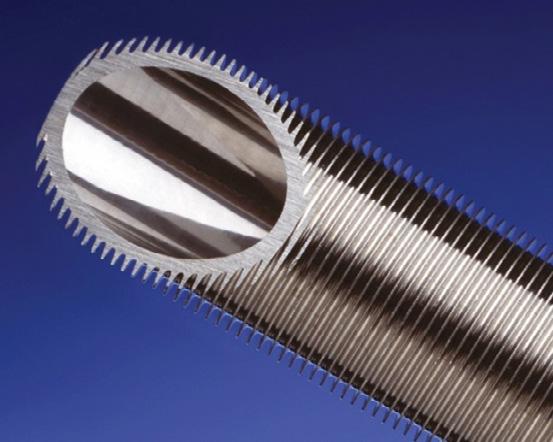Enhanced Titanium Tubing Addresses Demands For New Designs in Heat Exchanger Equipment By Wendy McGowan and Craig Thomas Titanium Fin Tubes
D
emand has emerged in many industries to not only provide innovative solutions for new heat exchanger equipment design improvements, but also to replace aged equipment with retrofit solutions that provide improved performance. Enhanced tubing surfaces have been developed as one solution to increase overall plant efficiencies. An integrally formed lowfin surface in titanium was first developed by High Performance Tube in 1974. The first set of installations took place at the Bayway Refinery in New Jersey, which was owned and operated by Exxon at the time. Brackish water from the Arthur Kill River was quickly destroying copper/nickel (Cu-Ni) tube bundles from the inside of the tubes and at the tube to tubesheet interface. Over the years, it was discovered 32
TITANIUMTODAY
that titanium tubes and titaniumclad tube sheets would solve the corrosion issue, but these retrofits would become expensive if the heat exchangers had to be completely resized with new shells, new infrastructure, and piping layouts. It also was discovered that retrofitting with finned titanium tubes greatly reduced the installation cost because the added surface area allowed for installing new bundles with higher or equal capacity into existing shells. The extended fin surface on the outside of the titanium tubing more than compensated for the loss in metal thermal conductivity and allowed for more future capacity. In addition, some of the existing CuNi or admiralty brass bundles were already installed as low-fin type. Replacing these bundles with finned titanium became imperative in order to maintain existing capacity. Since Neotiss’ acquisition of
High Performance Tube in 2008, the range of fin tube products available in titanium has expanded, and with that also the number of different industry applications. One example is the development of both external low-fin surfaces combined with a spirally grooved internal fin surface. This resulting dual enhanced titanium tube further improves heat transfer efficiency by increasing the shell side surface area and the tube-side turbulence. These tubes are commonly used in large refrigerant loop processes serving the commercial air conditioning and industrial process refrigeration markets. As explained in an article penned by Charles Young, business development manager/metallurgist for Tricor Metals, which was published in the first-quarter edition of TITANIUM TODAY, understanding the elements of





